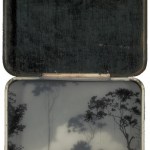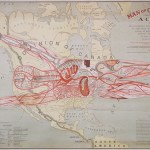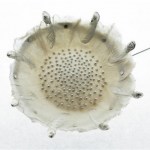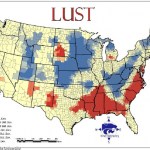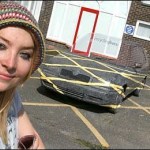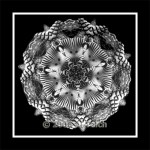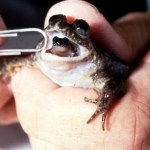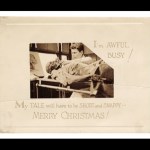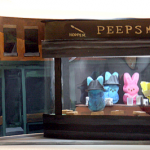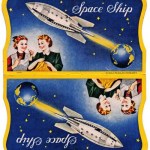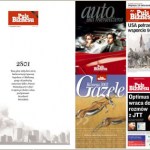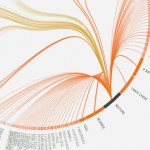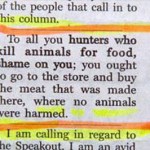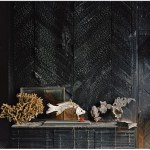ephemera
Los Angeles Electric Isle
Brooks Salzwedel
Brooks Salzwedel's solo show opened May 16 at the Tinlark Gallery.
The artist works in layers of graphite and translucent resin, which create an especially nice effect in vintage tins. Imagine if you picked up a rusty old tin on an abandoned worksite or in an old mining town, opened it, and found someone's half-remembered memory inside - gradually accreted there like candle wax. Salzwedel's work is a little like that.
Little Anacin Tin
Brooks Salzwedel
High Forest Tin
Brooks Salzwedel
Broken Wires
Brooks Salzwedel
Via NOTCOT
Another fabulously weird map, from the great blog Strange Maps. This one is entitled "The Man of Commerce" and dates to 1889.
According to the American Geographical Society Library,
The highly detailed 31" x 50" map/chart conflates human anatomy with the American transportation system, in an apparent attempt to promote Superior as a transportation hub.Its metaphor makes West Superior "the center of cardiac or heart circulation"; the railways become major arteries; and New York is "the umbilicus through which this man of commerce was developed."The explanatory notes conclude: "It is an…
Well, not really. Artist Carel Brest van Kempen timelapsed stills of an acrylic painting to show his work process. It's remarkable how quickly the anole comes to life!
I especially enjoy watching the glazes go on and come off - each time he blots out part of the painting, I think, "oh NO!" But that's because I work in watercolor, which is pretty near irreversible. Acrylic is much more forgiving.
This week, Nieman Journalism Lab is running a fascinating series of video interviews with the New York Times' R&D group on the possible future face of news media. I know - you're wondering why the supposedly financially moribund NYT is wasting money on nerds who play with Kindles. Who do they think they are, Google? But it might be a good strategy after all.
As Fortune and the Columbia Journalism Review recently pointed out, with outlets all around them slashing premium content (like science), the NYT's best strategy may be to instead become increasingly "elite:"
Meanwhile, the company is…
Long pin (detail)
Hand-made paper with cast silver seed inclusions and fine silver.
Sabrina Meyns
Irish artist Sabrina Meyns makes jewelry out of paper and silver. This piece may be less durable than your typical jewelry, but it's certainly more robust than the fragile poppies it mimics, and the translucency and delicacy is breathtaking. Unfortunately, her site only has a few examples of her work, but hopefully we'll see more of her in the future.
Via Daily Art Muse
Some Kansas State University geographers have come up with some interesting maps of the US that purport to show the national distribution of the seven deadly sins. Obviously they can't gauge "sinfulness" directly, so they're using proxy data - such as STD infection rate to measure lust (above).
It's a fun thought exercise to assess the pros and cons of the various methodologies for measuring each sin. Consider greed, which was (as described in the Las Vegas Sun) calculated by comparing average incomes with the total number of inhabitants living beneath the poverty line. How does that…
Following up on my previous post about visual illusions, reader Jake alerted me to this story from the BBC:
A design student made a battered old Skoda "disappear" by painting it to merge with the surrounding car park. Sara Watson, who is studying drawing at the University of Central Lancashire (Uclan), took three weeks to transform the car's appearance.
Note that like a trompe l'oeil painting in a building, or an anamorphic projection, the perspective work on the car will only allow it to "blend in" seamlessly when seen from a specific vantage point - which might be why we only have one…
Medallion
Al Teich
Al Teich's photographs are explorations of symmetry and rhythm that resemble snowflakes, diatoms, or pollen grains. His method fuses old and new technologies: he photographs kaleidoscopes with a digital camera, incrementally moving them to adjust the image. Teich told the Washington Post, "The images are very beautiful but transient. There is an infinite variety of them, but they disappear when you turn the kaleidoscope." Teich, who has a bachelor's degree in physics and a PhD in political science, says "scientists see and enjoy beauty in many things - in science, of…
Birth of the Gastric Brooding Frog
Photo Mike Tyler
Unfortunately, species are the ultimate bioephemera.
Amphibians in particular have been declining at an alarming rate over the past several decades; some estimates suggest that a third of amphibian species are on the verge of extinction. My latest essay for SEED's website opens with the story of the Gastric Brooding Frog, Rheobatrachus silus, an extremely peculiar species. It was discovered in the 1970s, and already believed extinct just over a decade later. That's barely enough time to describe a species, much less save it.
Save the Frogs…
Christmas greeting card, school unknown, circa 1920.
Dittrick Medical History Center
from Dissection: Photographs of a Rite of Passage in American Medicine 1880-1930
Slate has an intriguing new review by Barron Lerner of a book called Dissection: Photographs of a Rite of Passage in American Medicine 1880-1930, by John Harley Warner and James M. Edmonson. The book delves into the turn-of-the-century practice of photographing medical students with cadavers - photos that today read as weird, grotesque, even offensive.
The photos unearthed by Warner and Edmonson depict an astonishing variety of…
Light is an ephemeral but powerful artistic medium. This commercial for the Belgian energy company Electrabel captures the whimsical charm of fireflies on a warm summer night:
You can view a stunning higher-res version of this video here, with slightly different music. There is also a making-of video with scenes of the film shoot.
Thanks to Rhett for finding this one!
You've never heard "in real time" screamed with so much passion. Not just one, but two big-haired metal-band bio-rock videos after the fold. . .
(sources: here and here)
NightPeeps
Melissa Harvey (after Edward Hopper)
It's that time of year again! As I roasted blue Easter Peeps over the gas stove yesterday, I eagerly awaited this year's collection of Peep dioramas from the Washington Post - and here they are! View the complete Peeps Show here.
Be sure to check out "Double Peep Strike" (Miracle on the Hudson), Bernard Peepoff, and the Trek Peeps of Stardate 2351.6. Many dioramas play on DC themes: "Peep to the Right" refers to clueless tourists who stand on the left side of Metro escalators, blocking those of us who use public transit to get to work; "…
I find this 1950s-era needle book cover fascinating, because it mixes the stereotypically female activity of sewing with the stereotypically male interest in space travel. What is the connection here? Are these young women sewing spacesuits? Are they inspired by/chatting about the excitement of rocket science? Is there any tenuously plausible connection that can be made between a space ship named "The Moon" and sewing needles, other than that they are both silver?
View larger image
Ha! It turns out we can't even make that connection, because a closer look at the packaging reveals that the…
Scibling Bora has expressed his wish "to end once for all the entire genre of discussing the "bloggers vs. journalists" trope," and tried to do so with perhaps the most massive science-journalism-Web2.0 post evah.
Bora says,
the whole "bloggers will replace journalists" trope is silly and wrong. No, journalists will replace journalists. It's just that there will be fewer of them paid, and more of us unpaid. Some will be ex-newspapermen, others ex-bloggers, but both will be journalists. Instead of on paper, journalism will happen online. Instead of massaging your article to fit into two inches…
What's that you say? You still haven't joined Twitter? You don't see the point of constant 140-character status updates? Well, that's suddenly okay! You can emulate the many developing third-world nations who leaped directly over landline telephones to cell networks, and bypass Twitter entirely for the next big thing: Flutter.
Now what we really need to do is figure out ways to harness Flutter to replace the mainstream media and transform science. Imagine lab goggles with your friends' "flaps" scrolling across them: you'll never need to leave the bench to "have a life!" w00t!
Via…
Jacek Utko argues that there is no convincing reason why newspapers should survive - but that good design might be able to transform them into something more successful. In addition to numerous awards, Utko's fearless use of white space, bold color, and dramatic imagery has won significant increases in readership (up to 100%) for several Eastern European newspapers.
A real newspaper redesign involves more than changing the layout. The layout is essential, but by no means the only element. First we define the goal, later the necessary content-changes, and only then do we get to design.…
SEEDmagazine.com interviews Carl Bergstrom, whose eigenfactor project uses citation databases to map networks of information sharing within science:
We find papers to read by following citation trails. If you have an eigenfactor of 1.5, it means 1.5% of the time, a researcher following citation trails is actually trying to get an article from your journal. . . How do you make the right connections, right? How do you make the critical connections to move thought forward? If you can solve a problem like that, or even just make a little contribution to it, it really accelerates science in a…
From Failblog.
(I dedicate this to Hungry Hyaena, who holds extremely nuanced views on the ethics of hunting, and would no doubt have an easier time if he embraced complete denial, like this poor person).
Norwich State Hospital, Piano
"New England Ruins"
Rob Dobi, 2005
Three quietly stunning collections of photos mix the ache of loss with the unintentional but undeniable beauty of decay. First, Rob Dobi's "New England Ruins" documents abandoned buildings in various states of abandonment. His compositions vary from grand (abandoned stages and performance halls) to mundane (a chair fallen down a flight of stairs, the back of a derelict television). Norwich State Hospital, Piano (above) captures a broken piano, its innards undulating like the skeleton of a grilled trout, under a crude mosaic of…
